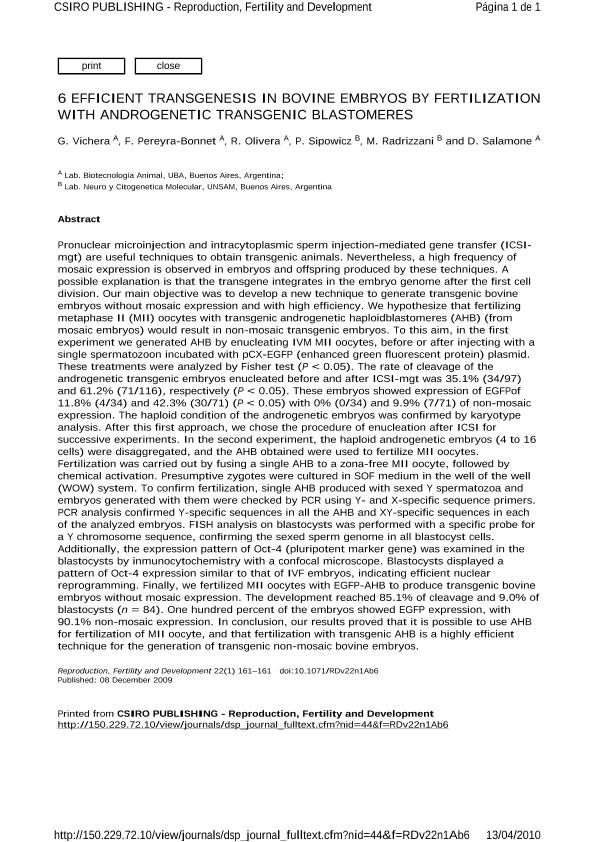Mostrar el registro sencillo del ítem
dc.contributor.author
Vichera, Gabriel Damian

dc.contributor.author
Pereyra Bonnet, Federico Alberto

dc.contributor.author
Olivera, Ramiro
dc.contributor.author
Sipowicz, Pablo
dc.contributor.author
Radrizzani Helguera, Martin

dc.contributor.author
Salamone, Daniel Felipe

dc.date.available
2018-07-30T21:50:00Z
dc.date.issued
2010-01
dc.identifier.citation
Vichera, Gabriel Damian; Pereyra Bonnet, Federico Alberto; Olivera, Ramiro; Sipowicz, Pablo; Radrizzani Helguera, Martin; et al.; 6 efficient transgenesis in bovine embryos by fertilization
with androgenetic transgenic blastomeres; Csiro Publishing; Reproduction Fertility and Development; 22; 1; 1-2010; 161-161
dc.identifier.issn
1031-3613
dc.identifier.uri
http://hdl.handle.net/11336/53540
dc.description.abstract
Pronuclear microinjection and intracytoplasmic sperm injection-mediated gene transfer (ICSI-mgt) are useful techniques to obtain transgenic animals. Nevertheless, a high frequency of mosaic expression is observed in embryos and offspring produced by these techniques. A possible explanation is that the transgene integrates in the embryo genome after the first cell division. Our main objective was to develop a new technique to generate transgenic bovine embryos without mosaic expression and with high efficiency. We hypothesize that fertilizing metaphase II (MII) oocytes with transgenic androgenetic haploidblastomeres (AHB) (from mosaic embryos) would result in non-mosaic transgenic embryos. To this aim, in the first experiment we generated AHB by enucleating IVM MII oocytes, before or after injecting with a single spermatozoon incubated with pCX-EGFP (enhanced green fluorescent protein) plasmid. These treatments were analyzed by Fisher test (P < 0.05). The rate of cleavage of the androgenetic transgenic embryos enucleated before and after ICSI-mgt was 35.1% (34/97) and 61.2% (71/116), respectively (P < 0.05). These embryos showed expression of EGFPof 11.8% (4/34) and 42.3% (30/71) (P < 0.05) with 0% (0/34) and 9.9% (7/71) of non-mosaic expression. The haploid condition of the androgenetic embryos was confirmed by karyotype analysis. After this first approach, we chose the procedure of enucleation after ICSI for successive experiments. In the second experiment, the haploid androgenetic embryos (4 to 16 cells) were disaggregated, and the AHB obtained were used to fertilize MII oocytes. Fertilization was carried out by fusing a single AHB to a zona-free MII oocyte, followed by chemical activation. Presumptive zygotes were cultured in SOF medium in the well of the well (WOW) system. To confirm fertilization, single AHB produced with sexed Y spermatozoa and embryos generated with them were checked by PCR using Y- and X-specific sequence primers. PCR analysis confirmed Y-specific sequences in all the AHB and XY-specific sequences in each of the analyzed embryos. FISH analysis on blastocysts was performed with a specific probe for a Y chromosome sequence, confirming the sexed sperm genome in all blastocyst cells. Additionally, the expression pattern of Oct-4 (pluripotent marker gene) was examined in the blastocysts by inmunocytochemistry with a confocal microscope. Blastocysts displayed a pattern of Oct-4 expression similar to that of IVF embryos, indicating efficient nuclear reprogramming. Finally, we fertilized MII oocytes with EGFP-AHB to produce transgenic bovine embryos without mosaic expression. The development reached 85.1% of cleavage and 9.0% of blastocysts (n = 84). One hundred percent of the embryos showed EGFP expression, with 90.1% non-mosaic expression. In conclusion, our results proved that it is possible to use AHB for fertilization of MII oocyte, and that fertilization with transgenic AHB is a highly efficient technique for the generation of transgenic non-mosaic bovine embryos.
dc.format
application/pdf
dc.language.iso
eng
dc.publisher
Csiro Publishing

dc.rights
info:eu-repo/semantics/openAccess
dc.rights.uri
https://creativecommons.org/licenses/by-nc-sa/2.5/ar/
dc.subject
Transgenic
dc.subject
Androgenetic
dc.subject
Bovine Embryos
dc.subject
Haploid
dc.subject.classification
Otras Producción Animal y Lechería

dc.subject.classification
Producción Animal y Lechería

dc.subject.classification
CIENCIAS AGRÍCOLAS

dc.title
6 efficient transgenesis in bovine embryos by fertilization
with androgenetic transgenic blastomeres
dc.type
info:eu-repo/semantics/article
dc.type
info:ar-repo/semantics/artículo
dc.type
info:eu-repo/semantics/publishedVersion
dc.date.updated
2018-07-30T15:40:57Z
dc.journal.volume
22
dc.journal.number
1
dc.journal.pagination
161-161
dc.journal.pais
Australia

dc.journal.ciudad
Collingwood
dc.description.fil
Fil: Vichera, Gabriel Damian. Consejo Nacional de Investigaciones Científicas y Técnicas; Argentina. Universidad de Buenos Aires. Facultad de Agronomía. Pabellón de Zootecnica. Laboratorio de Biotecnología Animal; Argentina
dc.description.fil
Fil: Pereyra Bonnet, Federico Alberto. Consejo Nacional de Investigaciones Científicas y Técnicas; Argentina. Universidad de Buenos Aires. Facultad de Agronomía. Pabellón de Zootecnica. Laboratorio de Biotecnología Animal; Argentina
dc.description.fil
Fil: Olivera, Ramiro. Universidad de Buenos Aires. Facultad de Agronomía. Pabellón de Zootecnica. Laboratorio de Biotecnología Animal; Argentina
dc.description.fil
Fil: Sipowicz, Pablo. Universidad Nacional de San Martín; Argentina
dc.description.fil
Fil: Radrizzani Helguera, Martin. Consejo Nacional de Investigaciones Científicas y Técnicas; Argentina. Universidad Nacional de San Martín; Argentina
dc.description.fil
Fil: Salamone, Daniel Felipe. Universidad de Buenos Aires. Facultad de Agronomía. Pabellón de Zootecnica. Laboratorio de Biotecnología Animal; Argentina. Consejo Nacional de Investigaciones Científicas y Técnicas; Argentina
dc.journal.title
Reproduction Fertility and Development

dc.relation.alternativeid
info:eu-repo/semantics/altIdentifier/url/http://www.publish.csiro.au/rd/rdv22n1ab6
dc.relation.alternativeid
info:eu-repo/semantics/altIdentifier/doi/http://dx.doi.org/10.1071/RDv22n1Ab6
Archivos asociados
